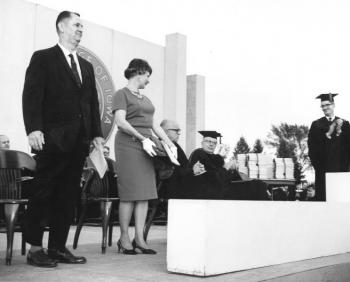Hibbs Memorial
On September 19, 2000, Governor Vilsack, President Koob, friends, family, and about two hundred others gathered in the area east of the West Gymnasium to dedicate a memorial to Lieutenant Robert J. Hibbs, Class of 1964, who received the Congressional Medal of Honor for his actions in Viet Nam.
During the dedication ceremony, Governor Vilsack reminded listeners of the sacrifices made by Americans in military service. President Koob stated that he regretted not having known Robert Hibbs personally while they were both students at the University of Northern Iowa, then known as the State College of Iowa, in the early 1960s.
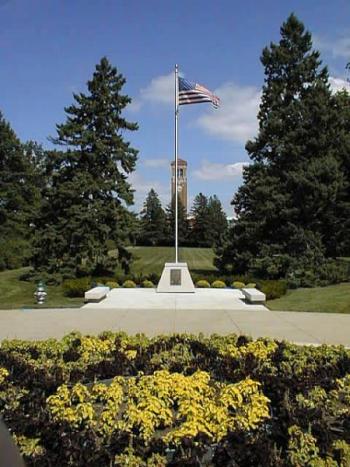
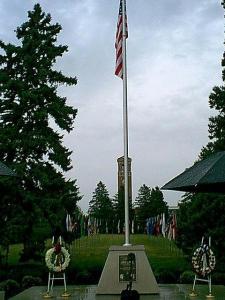
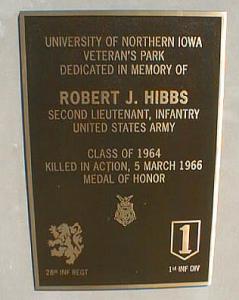
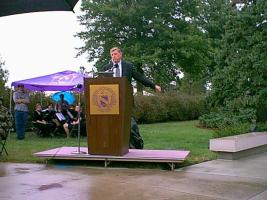
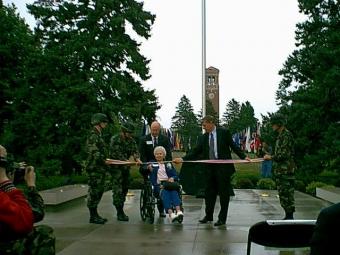
Robert Hibbs was born in Omaha, Nebraska, and later lived in Cedar Falls, Iowa. He received a degree from the State College of Iowa in 1964, after three years of study. While attending college, he worked thirty hours a week for a grocer. During one summer, he participated in the Social Science Seminar study tour in Europe. He was a member of Pi Gamma Mu, the social science honorary society. He planned to study law after completing military service.
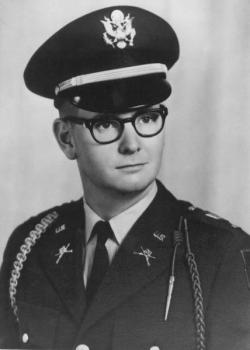
Hibbs entered the United States Army on August 23, 1964. He was commissioned as a second lieutenant at the Officer Candidate School at Fort Benning, Georgia, on June 22, 1965. He arrived in Vietnam in October 1965, assigned to the 1st Infantry Division.
On March 5, 1966, Lieutenant Hibbs was leading a 15-man ambush patrol of the 2nd Battalion, 28th Infantry Regiment near Don Dien Lo Ke. The patrol discovered a Viet Cong company of one hundred men on its way to attack his own unit. The patrol ambushed the Viet Cong, killing or wounding half of them. While returning to its own perimeter, the patrol discovered another Viet Cong company about to attack his unit. The patrol surprised the Viet Cong company and disrupted its attack. Lieutenant Hibbs realized that one of his men had been left wounded in an area under Viet Cong control. He and a sergeant went to retrieve their comrade. When they found the wounded man, the sergeant dragged him to safety and Lieutenant Hibbs provided covering fire. Lieutenant Hibbs was killed while attacking two machine gun emplacements. But before he died, he destroyed his starlight scope so that it would not fall into enemy hands.
For his gallant actions, Lieutenant Hibbs received the Congressional Medal of Honor, the nation's highest decoration for valor, in an order signed by President Lyndon Johnson on November 16, 1966. On January 26, 1967, Lieutenant Hibbs' family received the award from Secretary of the Army Stanley Resor. The text of the citation reads as follows:

Second Lieutenant Robert J. Hibbs, Infantry, distinguished himself by gallantry and intrepidity at the risk of his life above and beyond the call of duty on March 5, 1966 in the vicinity of Don Dien Lo Ke, Republic of Vietnam. Lieutenant Hibbs was in command of a fifteen-man ambush patrol of the 2d Battalion, 28th Infantry when his unit observed a company of Viet Cong advancing along the road toward the 2d Battalion's positions. Informing his command post by radio of the impending attack, he prepared his men for the oncoming Viet Cong, emplaced two mines in their path and, when the insurgents were within twenty feet of the patrol's position, he fired the two anti-personnel mines, wounding or killing half of the enemy company. Then, to cover the withdrawal of his patrol, he threw hand grenades, stepped onto the open road, and opened fire on the remainder of the Viet Cong force of approximately fifty men. Having rejoined his men, he was leading them toward the Battalion perimeter when the patrol encountered the rear elements of another Viet Cong company deployed to attack the Battalion. With the advantage of surprise, he directed a charge against the Viet Cong which carried the patrol through the insurgent force completely disrupting its attack. Learning that a wounded patrol member was wandering in the area between the two opposing forces and although moments from safety and wounded in the leg himself, he and a sergeant went back to the battlefield to recover the stricken man. After they maneuvered through the withering fire of two Viet Cong machine guns, the sergeant grabbed the dazed soldier and dragged him back toward the friendly lines while Lieutenant Hibbs remained behind to provide covering fire. Armed with only an M-16 rifle and a pistol, but determined to destroy the enemy positions, he then charged the two machine gun emplacements and was struck down. Before succumbing to his mortal wounds, he destroyed the starlight telescopic sight attached to his rifle to prevent its capture and use by the Viet Cong. Lieutenant Hibbs' conspicuous gallantry, his profound concern for his fellow soldiers, and his intrepidity at the risk of his life above and beyond the call of duty are in the highest traditions of the United States Army and reflect great credit upon himself and the armed forces of his country.
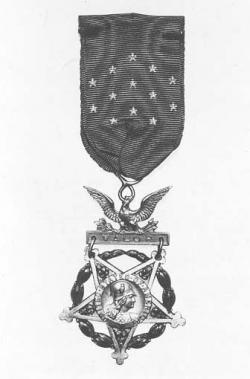
Lieutenant Hibbs was honored by the Iowa General Assembly on May 22, 1967. Speaker of the House Maurice Baringer introduced Hibbs' parents, Mr. and Mrs. Walter J. Hibbs, and asked for a minute of silent tribute. At the UNI Commencement ceremony on June 2, 1967, Lieutenant Hibbs was again honored. President Maucker introduced Mr. and Mrs. Hibbs and said:
We honor him this evening not only because of the courage he displayed in the face of death, but also because he was a young man who exemplified the traits of character that we are always proud to see in graduates of this institution. Many of Lieutenant Hibbs' instructors here remember him as the kind of student they like to have: bright, open, friendly, well-adjusted and interested; a good, solid student who especially liked history. They report him as self-reliant, industrious and a nice person to have around.
On November 11, 1997, the city of Cedar Falls named the new Main Street bridge over the Cedar River in honor of Lt. Hibbs. It is now called the Robert J. Hibbs Medal of Honor Bridge.
Research and graphical work by Library Assistant Gail Briddle; text by University Archivist Gerald L. Peterson, September 2000, July 2001; last updated, March 23, 2012.
